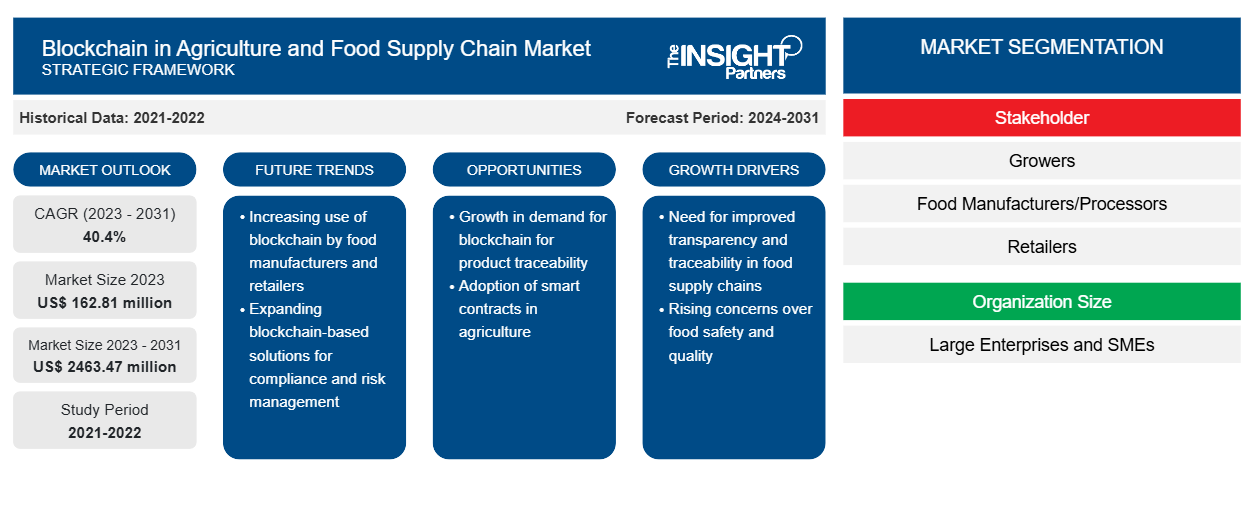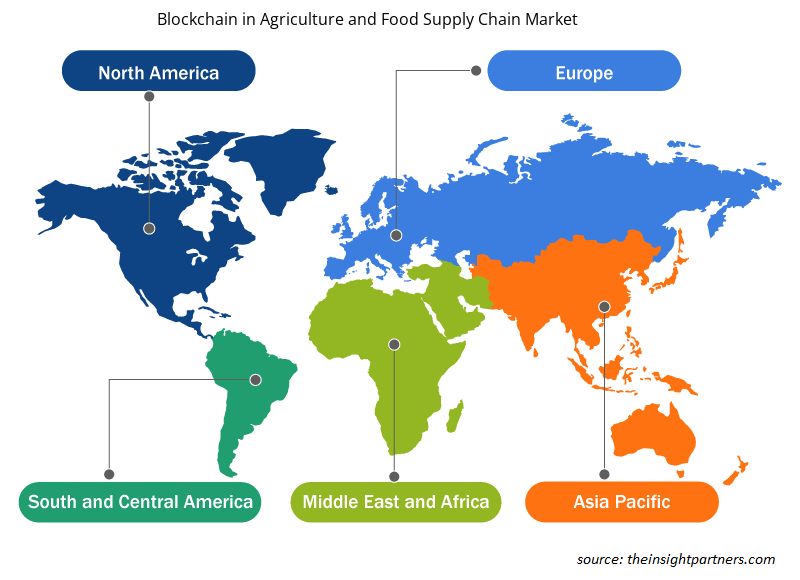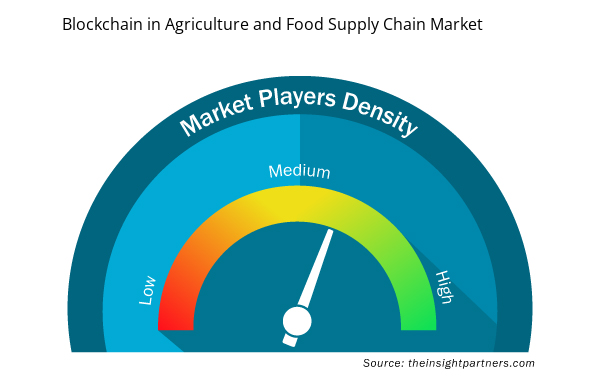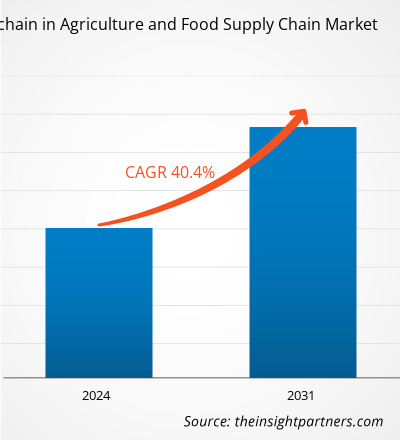Se espera que el tamaño del mercado de blockchain en la agricultura y la cadena de suministro de alimentos crezca de US$ 162,81 millones en 2023 a US$ 2463,47 millones en 2031; se anticipa que se expandirá a una CAGR del 40,4% entre 2023 y 2031. La trazabilidad y la transparencia mejoradas, la demanda de transparencia de los consumidores, la eficiencia de la cadena de suministro, la prevención del fraude y la contaminación de los alimentos y la reducción del desperdicio de alimentos están impulsando el crecimiento del mercado de blockchain en la agricultura y la cadena de suministro de alimentos.
Análisis del mercado de la cadena de bloques en la agricultura y la cadena de suministro de alimentos
La creciente demanda de tecnología blockchain por parte de las pequeñas y medianas empresas ha reforzado la presencia de la tecnología blockchain en el mercado de la agricultura y la cadena de suministro de alimentos. Además, se prevé que la integración de dispositivos de Internet de las cosas (IoT) acelere la expansión de los mercados durante el período previsto. Además, las principales empresas están tomando diversas iniciativas para ampliar su cartera y presencia global, lo que se ha convertido en una importante tendencia del mercado de la cadena de bloques en la agricultura y la cadena de suministro de alimentos.
Descripción general del mercado de la cadena de bloques en la agricultura y la cadena de suministro de alimentos
- Las empresas relacionadas con la agricultura están cada vez más interesadas en la tecnología blockchain. Las empresas se diferencian gradualmente al mostrar cómo se crea conocimiento sobre la cadena de suministro y se reducen los cuellos de botella en las transacciones mediante una mejor capacidad de gestión de datos que resulta del desarrollo de la tecnología.
- El sector agrícola destaca el valor de la tecnología para reducir los costos de transacción, agilizar la logística, impulsar la trazabilidad y mejorar los procedimientos de seguridad alimentaria.
- La tecnología Blockchain representa una oportunidad apasionante para mejorar la transparencia, reducir la resistencia e impulsar la eficiencia relacionada con las transacciones en las cadenas de suministro agrícola globales.
Personalice este informe según sus necesidades
Obtendrá personalización en cualquier informe, sin cargo, incluidas partes de este informe o análisis a nivel de país, paquete de datos de Excel, así como también grandes ofertas y descuentos para empresas emergentes y universidades.
Blockchain en el mercado de la agricultura y la cadena de suministro de alimentos: perspectivas estratégicas

- Obtenga las principales tendencias clave del mercado de este informe.Esta muestra GRATUITA incluirá análisis de datos, desde tendencias del mercado hasta estimaciones y pronósticos.
Oportunidad de mercado de la cadena de bloques en la agricultura y la cadena de suministro de alimentos
Integración de dispositivos de Internet de las cosas (IoT) para crear una oportunidad para el crecimiento del mercado de la cadena de bloques en la agricultura y la cadena de suministro de alimentos
- La incorporación de dispositivos de Internet de las cosas (IoT) con tecnología blockchain para la agricultura y las cadenas de suministro de alimentos mejora la recopilación de datos y el monitoreo en tiempo real, lo que genera una mayor transparencia, trazabilidad y control de calidad, así como una mayor eficiencia de la cadena de suministro.
- Las empresas están protegiendo los datos de los dispositivos de Internet de las cosas con blockchain. Los dispositivos inteligentes pueden intercambiar datos y realizar otras actividades financieras de forma escalable, segura y confiable cuando se utiliza la tecnología blockchain junto con los dispositivos de IoT.
- Además, la tecnología blockchain combinada con IoT permite a las organizaciones intercambiar y acceder a datos sin la necesidad de un control y una gestión centralizados, lo que impulsa aún más el crecimiento del mercado de blockchain en la agricultura y la cadena de suministro de alimentos.
Análisis de segmentación del informe de mercado de blockchain en la agricultura y la cadena de suministro de alimentos
- Según el tamaño de la organización, el mercado de blockchain en la agricultura y la cadena de suministro de alimentos se segmenta en grandes empresas y pymes. Se espera que el segmento de grandes empresas tenga una participación sustancial en el mercado de blockchain en la agricultura y la cadena de suministro de alimentos en 2023.
- Las organizaciones más grandes están trabajando continuamente para invertir en tecnologías avanzadas como blockchain para mejorar su agricultura y cadena de suministro de alimentos, lo que está impulsando el crecimiento del segmento en el mercado.
- Mientras tanto, las PYME también están trabajando en la adopción de la tecnología blockchain, ya que les ayuda a rastrear y administrar sus granos a medida que avanzan a lo largo de la cadena de valor, impulsando aún más el crecimiento del mercado en el período previsto.
Análisis de la participación de mercado de la cadena de bloques en la agricultura y la cadena de suministro de alimentos por geografía
El alcance del mercado de blockchain en la agricultura y la cadena de suministro de alimentos se divide principalmente en cinco regiones: América del Norte, Europa, Asia Pacífico, Oriente Medio y África, y América del Sur. América del Norte está experimentando un rápido crecimiento y se prevé que tenga una participación significativa en el mercado de blockchain en la agricultura y la cadena de suministro de alimentos. América del Norte adoptó tecnología moderna a un ritmo mucho más rápido que otras regiones para gestionar la agricultura y la cadena de suministro de alimentos, lo que resultó en la mayor participación de mercado. Además, Estados Unidos y Canadá son los países económicamente más estables de la región y representan una parte considerable del mercado.
Perspectivas regionales del mercado de la cadena de bloques en la agricultura y la cadena de suministro de alimentos
Los analistas de Insight Partners explicaron en detalle las tendencias y los factores regionales que influyen en el mercado de la cadena de bloques en la agricultura y la cadena de suministro de alimentos durante el período de pronóstico. Esta sección también analiza los segmentos y la geografía del mercado de la cadena de bloques en la agricultura y la cadena de suministro de alimentos en América del Norte, Europa, Asia Pacífico, Oriente Medio y África, y América del Sur y Central.

- Obtenga datos regionales específicos para el mercado de blockchain en la agricultura y la cadena de suministro de alimentos
Alcance del informe de mercado sobre la cadena de bloques en la agricultura y la cadena de suministro de alimentos
| Atributo del informe | Detalles |
|---|---|
| Tamaño del mercado en 2023 | US$ 162,81 millones |
| Tamaño del mercado en 2031 | US$ 2463,47 millones |
| CAGR global (2023 - 2031) | 40,4% |
| Datos históricos | 2021-2022 |
| Período de pronóstico | 2024-2031 |
| Segmentos cubiertos | Por parte de las partes interesadas
|
| Regiones y países cubiertos | América del norte
|
| Líderes del mercado y perfiles de empresas clave |
|
La cadena de bloques en la agricultura y la cadena de suministro de alimentos: densidad de actores del mercado: comprensión de su impacto en la dinámica empresarial
El mercado de la cadena de bloques en la agricultura y la cadena de suministro de alimentos está creciendo rápidamente, impulsado por la creciente demanda de los usuarios finales debido a factores como la evolución de las preferencias de los consumidores, los avances tecnológicos y una mayor conciencia de los beneficios del producto. A medida que aumenta la demanda, las empresas amplían sus ofertas, innovan para satisfacer las necesidades de los consumidores y aprovechan las tendencias emergentes, lo que impulsa aún más el crecimiento del mercado.
La densidad de actores del mercado se refiere a la distribución de las empresas o firmas que operan dentro de un mercado o industria en particular. Indica cuántos competidores (actores del mercado) están presentes en un espacio de mercado determinado en relación con su tamaño o valor total de mercado.
Las principales empresas que operan en el mercado de blockchain en la agricultura y la cadena de suministro de alimentos son:
- IBM
- Microsoft
- TE-FOOD Internacional GmbH
- Ambroso
- Red ACR
- SAP SE
Descargo de responsabilidad : Las empresas enumeradas anteriormente no están clasificadas en ningún orden particular.

- Obtenga una descripción general de los principales actores clave del mercado de blockchain en la agricultura y la cadena de suministro de alimentos
Análisis del mercado de blockchain en la agricultura y la cadena de suministro de alimentosSe llevó a cabo en función de las partes interesadas, el tamaño de la organización, la aplicación y la geografía. Sobre la base de las partes interesadas, el mercado se segmenta en productores, fabricantes/procesadores de alimentos y minoristas. Según el tamaño de la organización, el mercado se segmenta en grandes empresas y pymes. Según la aplicación, el mercado de blockchain en la agricultura y la cadena de suministro de alimentos se segmenta en trazabilidad de productos, pago y liquidación, contratos inteligentes y gestión de riesgos y cumplimiento de la gobernanza. Según la geografía, el mercado se segmenta en América del Norte, Europa, Asia Pacífico, Oriente Medio y África, y América del Sur.
Noticias y desarrollos recientes sobre el mercado de la cadena de bloques en la agricultura y la cadena de suministro de alimentos
Las empresas adoptan estrategias inorgánicas y orgánicas, como fusiones y adquisiciones en la cadena de bloques, en el mercado de la agricultura y la cadena de suministro de alimentos. A continuación, se enumeran algunos de los principales desarrollos recientes del mercado:
- En marzo de 2021, BlockApps, un proveedor de plataformas de cadena de bloques empresariales, anunció la expansión de la red TraceHarvest con Amazon Web Services (AWS). La solución de cadena de bloques TraceHarvest de BlockApps aprovechará AWS para brindar a los clientes del sector agrícola de TraceHarvest un acceso rápido y flexible a la nube. TraceHarvest permite a los clientes rastrear y seguir el ciclo de vida completo de los productos agrícolas a partir de la fuente de las semillas mediante la tecnología de cadena de bloques.
[Fuente: BlockApps, sitio web de la empresa]
- En enero de 2020, Farmer Connect e IBM anunciaron una nueva aplicación móvil para consumidores llamada "Thank My Farmer", que permitirá a los consumidores de café rastrear su café para comprender su calidad y origen e incluso apoyar al agricultor que cultivó los granos. Farmer Connect es una plataforma de trazabilidad impulsada por IBM Blockchain diseñada para ayudar a aumentar la trazabilidad, la eficiencia y la equidad en la cadena de suministro de café.
[Fuente: IBM, sitio web de la empresa]
Informe de mercado sobre la cadena de bloques en la agricultura y la cadena de suministro de alimentos: cobertura y resultados
El pronóstico del mercado de Blockchain en la agricultura y la cadena de suministro de alimentos se estima en función de varios hallazgos de investigación primaria y secundaria, como publicaciones de empresas clave, datos de asociaciones y bases de datos. El informe de mercado "Tamaño y pronóstico del mercado de Blockchain en la agricultura y la cadena de suministro de alimentos (2021-2031)" proporciona un análisis detallado del mercado que cubre las siguientes áreas:
- Tamaño del mercado y pronóstico a nivel global, regional y nacional para todos los segmentos clave del mercado cubiertos bajo el alcance.
- Dinámica del mercado como impulsores, restricciones y oportunidades clave.
- Principales tendencias futuras.
- Análisis PEST y FODA detallado
- Análisis del mercado global y regional que cubre las tendencias clave del mercado, los actores clave, las regulaciones y los desarrollos recientes del mercado.
- Análisis del panorama de la industria y la competencia que cubre la concentración del mercado, el análisis de mapas de calor, los actores clave y los desarrollos recientes.
- Perfiles detallados de empresas.
- Análisis histórico (2 años), año base, pronóstico (7 años) con CAGR
- Análisis PEST y FODA
- Tamaño del mercado Valor/volumen: global, regional, nacional
- Industria y panorama competitivo
- Conjunto de datos de Excel



Report Coverage
Revenue forecast, Company Analysis, Industry landscape, Growth factors, and Trends

Segment Covered
This text is related
to segments covered.

Regional Scope
North America, Europe, Asia Pacific, Middle East & Africa, South & Central America

Country Scope
This text is related
to country scope.
Preguntas frecuentes
The global blockchain in agriculture and food supply chain market was estimated to be US$ 162.81 billion in 2023 and is expected to grow at a CAGR of 40.4% during the forecast period 2023 - 2031.
Rising demand for traceability and transparency from stakeholders are the major factors that propel the global blockchain in agriculture and food supply chain market.
The strategic initiatives by market players are anticipated to play a significant role in the global blockchain in agriculture and food supply chain market in the coming years.
The global blockchain in agriculture and food supply chain market is expected to reach US$ 2463.47 million by 2031.
The key players holding majority shares in the global blockchain in agriculture and food supply chain market are IBM, Microsoft, TE-FOOD International GmbH, Ambrosus, and ACR-NET.
Trends and growth analysis reports related to Banking, Financial Services, and Insurance : READ MORE..
- IBM
- Microsoft
- TE-FOOD International GmbH
- Ambrosus
- ACR-NET
- SAP SE
- OriginTrail
- Provenance
- Chainvine
- Ripe.io
The Insight Partners performs research in 4 major stages: Data Collection & Secondary Research, Primary Research, Data Analysis and Data Triangulation & Final Review.
- Data Collection and Secondary Research:
As a market research and consulting firm operating from a decade, we have published and advised several client across the globe. First step for any study will start with an assessment of currently available data and insights from existing reports. Further, historical and current market information is collected from Investor Presentations, Annual Reports, SEC Filings, etc., and other information related to company’s performance and market positioning are gathered from Paid Databases (Factiva, Hoovers, and Reuters) and various other publications available in public domain.
Several associations trade associates, technical forums, institutes, societies and organization are accessed to gain technical as well as market related insights through their publications such as research papers, blogs and press releases related to the studies are referred to get cues about the market. Further, white papers, journals, magazines, and other news articles published in last 3 years are scrutinized and analyzed to understand the current market trends.
- Primary Research:
The primarily interview analysis comprise of data obtained from industry participants interview and answers to survey questions gathered by in-house primary team.
For primary research, interviews are conducted with industry experts/CEOs/Marketing Managers/VPs/Subject Matter Experts from both demand and supply side to get a 360-degree view of the market. The primary team conducts several interviews based on the complexity of the markets to understand the various market trends and dynamics which makes research more credible and precise.
A typical research interview fulfils the following functions:
- Provides first-hand information on the market size, market trends, growth trends, competitive landscape, and outlook
- Validates and strengthens in-house secondary research findings
- Develops the analysis team’s expertise and market understanding
Primary research involves email interactions and telephone interviews for each market, category, segment, and sub-segment across geographies. The participants who typically take part in such a process include, but are not limited to:
- Industry participants: VPs, business development managers, market intelligence managers and national sales managers
- Outside experts: Valuation experts, research analysts and key opinion leaders specializing in the electronics and semiconductor industry.
Below is the breakup of our primary respondents by company, designation, and region:

Once we receive the confirmation from primary research sources or primary respondents, we finalize the base year market estimation and forecast the data as per the macroeconomic and microeconomic factors assessed during data collection.
- Data Analysis:
Once data is validated through both secondary as well as primary respondents, we finalize the market estimations by hypothesis formulation and factor analysis at regional and country level.
- Macro-Economic Factor Analysis:
We analyse macroeconomic indicators such the gross domestic product (GDP), increase in the demand for goods and services across industries, technological advancement, regional economic growth, governmental policies, the influence of COVID-19, PEST analysis, and other aspects. This analysis aids in setting benchmarks for various nations/regions and approximating market splits. Additionally, the general trend of the aforementioned components aid in determining the market's development possibilities.
- Country Level Data:
Various factors that are especially aligned to the country are taken into account to determine the market size for a certain area and country, including the presence of vendors, such as headquarters and offices, the country's GDP, demand patterns, and industry growth. To comprehend the market dynamics for the nation, a number of growth variables, inhibitors, application areas, and current market trends are researched. The aforementioned elements aid in determining the country's overall market's growth potential.
- Company Profile:
The “Table of Contents” is formulated by listing and analyzing more than 25 - 30 companies operating in the market ecosystem across geographies. However, we profile only 10 companies as a standard practice in our syndicate reports. These 10 companies comprise leading, emerging, and regional players. Nonetheless, our analysis is not restricted to the 10 listed companies, we also analyze other companies present in the market to develop a holistic view and understand the prevailing trends. The “Company Profiles” section in the report covers key facts, business description, products & services, financial information, SWOT analysis, and key developments. The financial information presented is extracted from the annual reports and official documents of the publicly listed companies. Upon collecting the information for the sections of respective companies, we verify them via various primary sources and then compile the data in respective company profiles. The company level information helps us in deriving the base number as well as in forecasting the market size.
- Developing Base Number:
Aggregation of sales statistics (2020-2022) and macro-economic factor, and other secondary and primary research insights are utilized to arrive at base number and related market shares for 2022. The data gaps are identified in this step and relevant market data is analyzed, collected from paid primary interviews or databases. On finalizing the base year market size, forecasts are developed on the basis of macro-economic, industry and market growth factors and company level analysis.
- Data Triangulation and Final Review:
The market findings and base year market size calculations are validated from supply as well as demand side. Demand side validations are based on macro-economic factor analysis and benchmarks for respective regions and countries. In case of supply side validations, revenues of major companies are estimated (in case not available) based on industry benchmark, approximate number of employees, product portfolio, and primary interviews revenues are gathered. Further revenue from target product/service segment is assessed to avoid overshooting of market statistics. In case of heavy deviations between supply and demand side values, all thes steps are repeated to achieve synchronization.
We follow an iterative model, wherein we share our research findings with Subject Matter Experts (SME’s) and Key Opinion Leaders (KOLs) until consensus view of the market is not formulated – this model negates any drastic deviation in the opinions of experts. Only validated and universally acceptable research findings are quoted in our reports.
We have important check points that we use to validate our research findings – which we call – data triangulation, where we validate the information, we generate from secondary sources with primary interviews and then we re-validate with our internal data bases and Subject matter experts. This comprehensive model enables us to deliver high quality, reliable data in shortest possible time.

 Obtenga una muestra gratuita de este informe
Obtenga una muestra gratuita de este informe